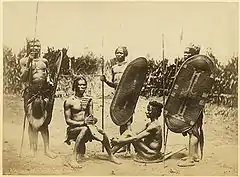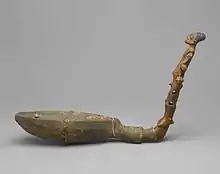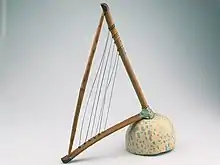African harp
African Harps, particularly arched or "bow" harps, are found in several Sub-Saharan African music traditions, particularly in the north-east. Used from early times in Africa, they resemble the form of harps in ancient Egypt with a vaulted body of wood, parchment faced, and a neck, perpendicular to the resonant face, on which the strings are wound.

Ancient Egyptian harps
 Harp from the Middle Kingdom, with soundboard-skin gone. The wooden bar that the strings were tied to is visible, a Art the pegs on the neck.
Harp from the Middle Kingdom, with soundboard-skin gone. The wooden bar that the strings were tied to is visible, a Art the pegs on the neck.
 Picture shown variety of Egyptian harps.
Picture shown variety of Egyptian harps. Harp, Late Second Intermediate Period–early New Kingdom, Dynasty 17–18
Harp, Late Second Intermediate Period–early New Kingdom, Dynasty 17–18_MET_DP302724.jpg.webp) Egyptian harp, New Kingdom, 18th dynasty
Egyptian harp, New Kingdom, 18th dynasty
Enanga

The ennanga, nanga, nnanga or enanga is a type of arched harp played by the Ganda people of Uganda. The sound box is made of a single piece of wood and roughly hemispherical. The top of the box is a stretched resonant membrane made of antelope skin, tied to a piece of hide at the bottom of the box. The neck is attached to the inside of the box, exits through a small round opening on the membrane, and curves upward for about 60 to 70 cm. Seven or eight strings are attached to a piece of wood inside the box, and extend through the skin to tuning pegs inserted along the neck. Sometimes small metallic rattling pieces are attached to the pegs, to color the sound. It is usually used to accompany men's singing.
 Ennanga, 19th century, instrument of the Ganda people
Ennanga, 19th century, instrument of the Ganda people
Abalanga (harpist) are skilled performers and composers who work within a very structured paradigm to ensure that no two abalanga performances are the same.[1]
Kundi

The kundi is the five-string harp of the Azande and related people of Central Africa. It is an instrument traditionally played by young men and boys.[2] A similar type of harp played by the Nzakara people. The instruments are well known for their ornately carved heads. The instrument has generally fallen from popularity, though in 1993 some older players were recorded on the album Central African Republic: music of the former Bandia courts.[3][4]
Gallery
.jpg.webp) Sudan. Mangbetu people harp
Sudan. Mangbetu people harp Gabonese harp played by Lord Ekomy Ndong, a Gabonese Hip-Hop musician
Gabonese harp played by Lord Ekomy Ndong, a Gabonese Hip-Hop musician Gabon, harp, 19th century
Gabon, harp, 19th century Uganda. Adungo harp.
Uganda. Adungo harp. Uganda. Adungo harp.
Uganda. Adungo harp. An arched harp of the Mbaka people, from the Democratic Republic of the Congo
An arched harp of the Mbaka people, from the Democratic Republic of the Congo Zande harp player
Zande harp player
 Loma, an African harp that is not arched.
Loma, an African harp that is not arched.
See also
- African music
- Kafir harp
- Kora
- Gravikord
- Congolese franc#Second franc, 1997– The 5 cent banknote has a Zande harp on its reverse.
References
- Rachel, Muehrer (2012). "Playing techniques of the nnanga of Buganda". African Music: Journal of the International Library of African Music. Grahamstown: International Library of African Music, Rhodes University. 9 (2): 57–76. doi:10.21504/amj.v9i2.1804. ISSN 0065-4019. Retrieved 3 September 2016.
- Daniela. "Bring n Braai". Archived from the original on 29 April 2009. Retrieved 25 April 2009.
- Gérard Assayag; Hans G. Feichtinger; José-Francisco Rodrigues; European Mathematical Society (2002). Mathematics and music: a Diderot Mathematical Forum. Springer. p. 170. ISBN 978-3-540-43727-7.
- Eric de Dampierre; Marc Chemillier (1996). République centrafricaine: musiques des anciennes cours Bandia. Chant du monde: Diffusion, Harmonia Mundi. OCLC 36899932.
- Chisholm, Hugh, ed. (1911). . Encyclopædia Britannica. 19 (11th ed.). Cambridge University Press.
